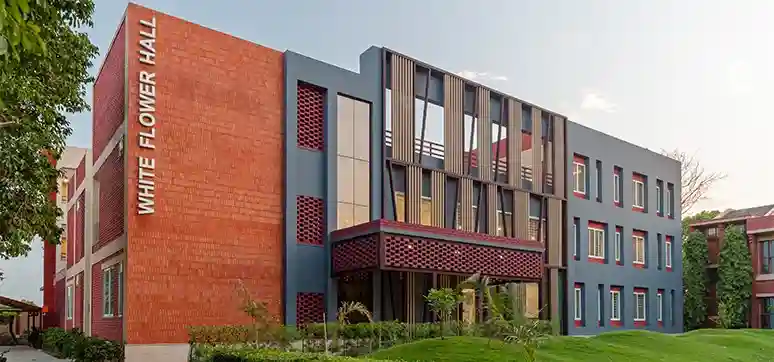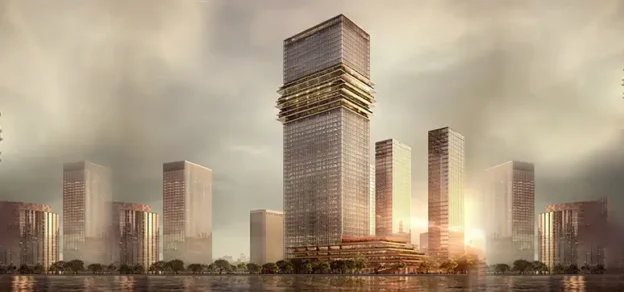The design for the Girls’ Hostel at The Mann School centers on the importance of providing facilities to promote learning and all-round development at a home-away-from-home. The hostel building was proposed within the complex of the school since the existing boarding facilities could not cater to the increasing number of students and their requirements. The idea was to create a safe environment for the girls with all the necessary functional requirements and a multitude of public spaces.

The new building is positioned between the executive block and the senior academic wing and houses dormitories for grades 1-12, a study hall, and common recreational areas like a games and television room, a computer room, and a salon. It carries on the legacy of the school ethos with openness and continuity as part of the design intent.
The campus’ existing colour scheme of red and grey is maintained while brick is used as a critical design element on the façades to help the new building blend cohesively within its surroundings. A metal jaali is also installed on the façade of the hostel building, supplemented by the lush greenery so that the building does not stick out like a sore thumb with too much-built mass.

For the well-being of the children, creating outdoor spaces such as gardens and terraces and incorporating greenery within the building was prioritised. The hostel is planned to overlook a central courtyard, with dormitories facing the corridors to ensure a lively and interactive environment. The corridors are widened in an angular fashion to accommodate seating spaces for children to relax. The building opens out at a different angle on every floor, with inward-looking terraces staggered to help create a sense of visual connection for everyone, regardless of where they are positioned.
The residential facilities for younger children (grades 1-4) are planned on the ground floor, so they don’t have to climb up the stairs, thus ensuring safety. The dormitories are designed to ensure optimal ingress of daylight and ventilation with windows along the custom-designed bunk beds, allowing each child a view of the outside. The dining area, the parent’s lounge, as well as recreational spaces like the indoor play area, are also located on the ground floor.
The first and second floors, on the other hand, are dedicated to facilities for older students: 4-bedded and 6-bedded dormitories with individual beds and study areas. The infirmary and the salon are also positioned on the first floor to accommodate all the facilities in one place, making the hostel self-sufficient. All the activity areas like the common room, computer lab, and games room are planned in the basement around the central courtyard and the sunken amphitheater, making it the most lively zone in the building.

Safety was considered an essential part of the design. The warden’s residence is planned within the building and overlooks the central courtyard, giving her a complete view of the hostel from her living room while retaining a sense of privacy. Also, the number of building entry and exit points are reduced, windows are fitted with metal grills, and criss-cross wires are used between the handrails in the corridors and the ceiling as a precaution.

Driven by sustainability, solar panels are installed on the terrace of the building. The central courtyard is precisely aligned in the northwest-southeast direction, to catch the southwesterly winds during the monsoon, thus ensuring ventilation throughout the building.
The south and west walls of the building are made with the rattrap bond (bricks are placed in a vertical position instead of a conventional horizontal position, creating a cavity) to provide thermal comfort. Mud phuska (compacted soil with hay) is used for thermal insulation to reduce the ingress of heat by almost 70%. Bricks used on-site have been procured from local kilns to reduce the carbon footprint. Even the finishes and materials used in the building are low maintenance and affordable – paint and tiles, granite, and laminates on the door – all keeping in mind that the setting is to be used by young children.

All the site-excavated earth from the basement is used to level and create mounds in the garden in front of the girl’s hostel. The debris that came out of the construction material was utilised to make the roads and footpaths of the school. Timber from old trees withering away on site was used to manufacture doors for the building. Additionally, rainwater is harvested from the 650 sqm. terrace into two pits through a series of drains and used for horticulture and flushing.
A home away from home – the Girls Hostel at Mann School, New Delhi follows an empathetic design approach, offering children a safe learning environment with the freedom to interact, engage and grow.
Quick Facts:
• Project: The Mann School – WhiteFlower Hall (Girls Hostel)
• Location: Delhi
• Client: The Mann School
• Design firm: Envisage
• Principal Architects: Meena Murthy Kakkar, Vishal Kakkar
• Design Team: Akanksha, Varun Seth, Pankaj Chawla, Payal Gupta
• Site Area: 5000 Sq m
• Built-Up Area: 3000 Sq m
• Start Date: December 2018
• Completion Date: January 2020
• Photographer: Suryan and Dang














